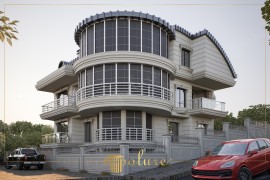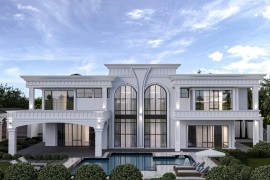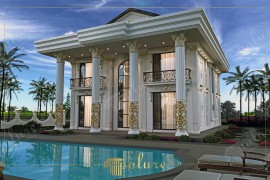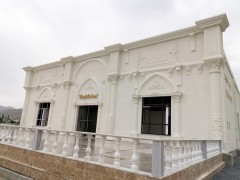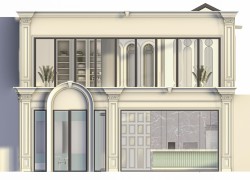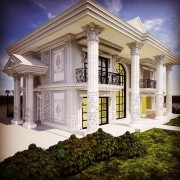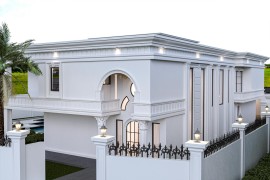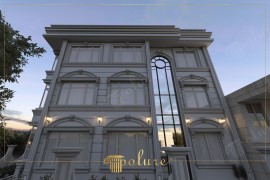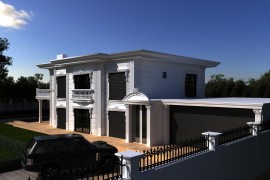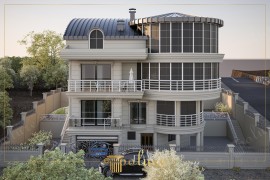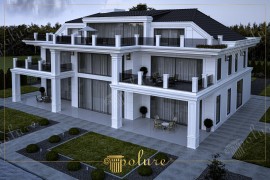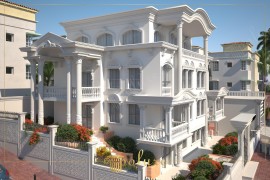Polyurethane Precast Videos
Efficient Installation: Lightweight Polyurethane Precast Villa Exterior Decor.
Polyurethane Precast villa exterior decoration designs have become increasingly popular in Ankara, Turkey. This innovative and versatile material offers a wide range of benefits for homeowners looking to enhance the aesthetic appeal of their properties. With its durability, flexibility, and cost-effectiveness, polyurethane precast is revolutionizing the way we approach building exterior decorations. One of the key advantages of polyurethane precast is its durability. Unlike traditional materials such as wood or concrete, polyurethane is resistant to weathering, cracking, and fading. This means that homeowners can enjoy the beauty of their villa exteriors for years to come without worrying about constant maintenance or repairs. Additionally, polyurethane precast is highly resistant to pests, moisture, and rot, making it an ideal choice for the Turkish climate. Flexibility is another standout feature of polyurethane precast. This material can be molded into various shapes and sizes, allowing homeowners to achieve their desired design aesthetic. Whether you prefer a classic, traditional look or a modern, contemporary style, polyurethane precast can be customized to meet your specific requirements. From ornate moldings and cornices to decorative columns and window trims, the possibilities are endless. Furthermore, polyurethane precast offers a cost-effective solution for villa exterior decorations. Compared to traditional materials, such as stone or wood, polyurethane is significantly more affordable. Its lightweight nature also reduces transportation and installation costs, making it a budget-friendly option for homeowners. Moreover, polyurethane precast requires minimal maintenance, saving homeowners both time and money in the long run. In addition to its practical benefits, polyurethane precast also provides environmental advantages. This material is made from a combination of polyols and isocyanates, which are derived from petroleum. However, advancements in technology have allowed for the production of eco-friendly polyurethane precast, which utilizes bio-based polyols made from renewable resources. This sustainable option reduces the environmental impact of villa exterior decorations and contributes to a greener future. When it comes to installation, polyurethane precast offers a hassle-free process. The lightweight nature of this material allows for easy handling and transportation, making the installation process quick and efficient. Whether you choose to hire professionals or undertake the project yourself, polyurethane precast simplifies the construction process, saving time and effort. In conclusion, polyurethane precast villa exterior decoration designs are revolutionizing the way we approach building aesthetics in Ankara. With its durability, flexibility, cost-effectiveness, and environmental advantages, this material is an excellent choice for homeowners looking to enhance the beauty of their properties. Whether you prefer a classic or modern design, polyurethane precast can be customized to meet your specific needs. Invest in polyurethane precast and transform your villa into a stunning masterpiece.
Customize Your Villa Exterior: Polyurethane Precast & Jamb Models
When it comes to designing the exterior of a villa, one must ensure that it exudes magnificence and beauty. And what better way to achieve this than by incorporating a quality exterior application? By utilizing different stone and panel applications, you can drastically transform the appearance of your villa and make it truly stand out. Architects play a crucial role in creating a villa exterior cladding that is not only visually appealing but also suitable for the overall design of the villa. One of the newer solutions that architects can utilize is the use of exterior panels, which provide a high-quality solution for enhancing the aesthetics of your villa. With the use of various materials such as stone, glass, and wood, your villa can be transformed into a stunning masterpiece. Each material offers its own unique charm and can be tailored to suit your personal preferences and architectural style. Whether you prefer the timeless elegance of stone, the sleek and modern look of glass, or the warm and inviting feel of wood, there is a material that can perfectly complement your villa's design. Stone applications are a popular choice for villa exteriors as they exude a sense of grandeur and timelessness. From natural stone to manufactured stone veneers, there are numerous options available to create a stunning façade that will leave a lasting impression. Stone cladding can be used to cover the entire exterior of the villa or incorporated as accent features to add depth and texture. Glass is another material that can be used to create a visually striking exterior. It allows for ample natural light to enter the villa, creating a bright and airy ambiance. Glass panels can be used to create floor-to-ceiling windows, glass walls, or even glass facades, providing a seamless connection between the interior and exterior spaces. This modern and minimalist approach can give your villa a sleek and sophisticated look. For those who prefer a more natural and rustic feel, wood applications are an excellent choice. Wood cladding can be used to create a warm and inviting exterior, evoking a sense of coziness and charm. Whether you opt for traditional wood siding or contemporary wood paneling, this material can add character and personality to your villa's façade. In conclusion, the exterior design of a villa plays a crucial role in its overall appeal. By incorporating high-quality exterior applications, such as stone, glass, or wood, you can transform your villa into a magnificent and beautiful masterpiece. Architects can help you choose the right materials and create a design that perfectly suits your preferences and architectural style. To learn more about villa exterior cladding and the various options available, visit our website.
Durable Polyurethane Capitals: Weather-Resistant Models
Polyurethane column capitals are an exquisite addition to any architectural project. These intricately designed models offer a touch of elegance and sophistication to columns, creating a stunning visual impact. With their versatility and durability, polyurethane column capitals have become increasingly popular among designers and homeowners alike. One of the key advantages of polyurethane column capitals is their lightweight nature. Unlike traditional materials such as stone or wood, polyurethane is a lightweight material that can be easily installed and maneuvered. This makes it an ideal choice for both new construction projects and renovation work, as it minimizes the effort and time required for installation. Another significant benefit of polyurethane column capitals is their exceptional durability. Made from high-quality polyurethane foam, these capitals are resistant to weather elements, including moisture, heat, and UV rays. This ensures that the capitals retain their original appearance and structural integrity for an extended period, even when exposed to harsh environmental conditions. Polyurethane column capitals also offer an extensive range of design options. Whether you prefer a classic, ornate style or a more contemporary and minimalist design, there are countless models available to suit your taste. From intricate floral patterns to simple geometric shapes, the versatility of polyurethane allows for endless possibilities when it comes to column capital designs. In addition to their aesthetic appeal, polyurethane column capitals also serve a functional purpose. They provide structural support to columns, acting as a protective barrier against wear and tear. This not only enhances the longevity of the columns but also ensures their stability and strength, making them an integral part of any architectural project. Furthermore, polyurethane column capitals are incredibly easy to maintain. Unlike materials such as stone or wood, which require regular sealing and polishing, polyurethane capitals only need occasional cleaning with mild soap and water. This makes them a practical choice for busy homeowners or commercial properties, as they require minimal upkeep while still maintaining their pristine appearance. When it comes to affordability, polyurethane column capitals are a cost-effective option. Compared to traditional materials, such as stone or wood, polyurethane is significantly more budget-friendly. This allows homeowners and designers to achieve the desired aesthetic without breaking the bank, making polyurethane column capitals an excellent choice for those looking to add a touch of luxury to their spaces without compromising on quality. In conclusion, polyurethane column capitals offer a wide range of benefits, including their lightweight nature, durability, design versatility, functional support, easy maintenance, and affordability. These models are an excellent investment for anyone looking to enhance the visual appeal and structural integrity of their columns. With their ability to withstand various weather conditions and their timeless designs, polyurethane column capitals are sure to leave a lasting impression on any architectural project.
Enhancing Villa Exteriors: Polyurethane Cladding & 3D Modeling
Polyurethane villa exterior cladding decoration has become a popular choice among homeowners and designers alike. This versatile material offers a range of benefits, making it an excellent option for enhancing the aesthetics and durability of villa designs. When it comes to housing designs, the exterior cladding plays a crucial role in protecting the structure from weather elements while adding an attractive touch. Polyurethane cladding offers exceptional resistance to UV rays, moisture, and temperature fluctuations, ensuring long-lasting performance and minimal maintenance requirements. Additionally, it provides excellent insulation properties, contributing to energy efficiency and reducing heating and cooling costs. Antalya, known for its stunning landscapes and vibrant business centers, can greatly benefit from the use of polyurethane cladding in its architectural designs. The material's versatility allows for various styles and finishes, enabling designers to create unique and visually appealing business center designs. Whether it's a sleek and modern look or a more traditional and rustic feel, polyurethane cladding can bring these concepts to life while providing durability and protection. Residence designs can also benefit from polyurethane cladding, as it offers endless design possibilities. With a wide range of colors, textures, and patterns available, homeowners can customize their villa exteriors to reflect their personal style and preferences. The lightweight nature of polyurethane cladding makes it easy to install, reducing construction time and costs. Hotels, being a hub for tourists and visitors, require designs that are not only visually appealing but also durable and low-maintenance. Polyurethane cladding checks all these boxes, making it an ideal choice for hotel designs. It can withstand heavy foot traffic, resist impacts, and maintain its original appearance for years to come. Whether it's a luxurious resort or a boutique hotel, polyurethane cladding can elevate the overall design and enhance the guest experience. The interior design of a villa is just as important as its exterior, and polyurethane cladding can be used to create stunning living room designs, kitchen designs, bathroom designs, bedroom designs, and kids room designs. Its versatility allows for seamless integration with various design elements, such as furniture, lighting, and accessories. Polyurethane cladding can add a touch of elegance and sophistication to any interior space, creating a warm and inviting atmosphere. The entrance hall is the first impression visitors have of a villa, and polyurethane cladding can make it a memorable one. With its ability to mimic the appearance of natural materials like wood and stone, polyurethane cladding can create a grand entrance hall that exudes luxury and sophistication. It can also be used in apartment entrance designs and building entrance designs to enhance the overall aesthetic appeal. Hamam designs, lobby designs, and sauna designs can also benefit from the use of polyurethane cladding. Its moisture resistance and durability make it an excellent choice for these areas, where water and humidity are prevalent. Polyurethane cladding can create a spa-like ambiance, providing a relaxing and rejuvenating experience for users. In the realm of design, visualizing concepts is crucial, and polyurethane cladding can aid in this process. With 3D residence design and 2D floor plan services, designers can accurately represent their ideas and help clients visualize the final result. Additionally, 3D floor plan, exterior, and interior designs can showcase the potential of a space, allowing for better decision-making and planning. Polyurethane cladding is not limited to residential designs; it can also be used in shopping mall designs, industrial product designs, and landscape studies. Its versatility and durability make it suitable for various applications, providing a cohesive and visually appealing look to these spaces. Furthermore, 3D building modeling allows designers and architects to create virtual representations of their designs, aiding in the planning and construction process. This technology enables stakeholders to visualize the final result, identify potential issues, and make necessary adjustments before the actual construction begins. Restaurant designs can greatly benefit from the use of polyurethane cladding. Its ability to mimic various materials allows designers to create unique and eye-catching spaces. Whether it's a cozy café or a high-end restaurant, polyurethane cladding can add a touch of elegance and sophistication to the overall design. In conclusion, polyurethane villa exterior cladding decoration offers numerous benefits and design possibilities. From villa designs to hotel designs, living room designs to restaurant designs, this versatile material can elevate the aesthetics and functionality of any space. With its durability, low maintenance requirements, and visual appeal, polyurethane cladding is a top choice for designers and homeowners alike.
Polure - Polyurethane Decoration Fair 2018
Polyurethane Decoration Material Increasing Popularity in Indoors and Outdoors Jamb Polyurethane Jamb Models Manufacturing Jamb Prices catalog from Production polure
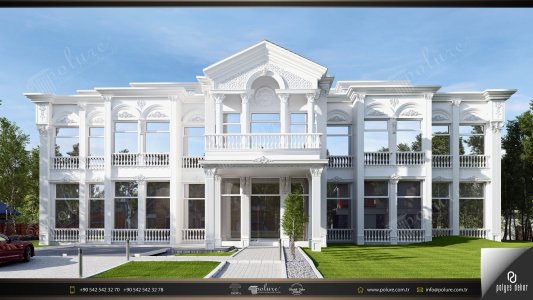
Polyurethane precast refers to objects or materials made beforehand using polyurethane, a type of plastic. These objects are created in a factory setting before being installed or used in their final location.
Polyurethane precast refers to the process and product of using polyurethane, a type of polymer, in the creation of building materials and architectural elements before they are installed at a construction site. This method involves casting the polyurethane material into molds to create various shapes and sizes, which can then be used in a wide range of construction applications. Polyurethane is favored in precast applications for several reasons. Its versatility allows it to be molded into intricate designs and shapes, making it suitable for decorative architectural elements such as moldings, columns, and balustrades. Additionally, polyurethane is lightweight compared to traditional materials like concrete and stone, which reduces the structural load on buildings and simplifies installation. Furthermore, polyurethane exhibits excellent durability and resistance to weather, chemicals, and wear, making it an ideal choice for both interior and exterior applications. Polyurethane precast products are used in a variety of construction and architectural applications. These include decorative elements like window surrounds, door frames, and architectural moldings, as well as functional components such as panels and cladding. Due to its insulation properties, polyurethane is also used in precast insulated panels, improving energy efficiency in buildings. In conclusion, polyurethane precast offers a versatile, durable, and efficient alternative to traditional construction materials. Its ability to be molded into complex shapes and its superior material properties make it an increasingly popular choice in modern construction and architectural design.Polyurethane Precast Explained
Why Use Polyurethane in Precast?
Advantages of Polyurethane Precast
Applications of Polyurethane Precast
Polyurethane precasts have a significant role in history due to their wide application in various industries, providing efficient, durable, and versatile solutions for manufacturing and construction.
Polyurethane precast has played a pivotal role in the development and evolution of materials technology over the past few decades. This synthetic material, known for its versatility, durability, and resistance to environmental factors, has found applications in a wide range of industries, from construction and automotive to furniture and footwear. The history of polyurethane precast is a testament to human ingenuity in the search for materials that combine practicality with performance. Polyurethane was first developed in the late 1930s by Otto Bayer and his coworkers in Germany. Initially, it was used primarily in military applications during World War II, such as for the manufacture of aircraft coatings and as a replacement for rubber, which was scarce due to wartime shortages. However, its potential for other uses quickly became apparent in the post-war period. In the following decades, the technology for producing polyurethane evolved, leading to its application in precast forms. Precast polyurethane components could be manufactured in factories under controlled conditions before being transported to construction sites or other areas of use. This innovation significantly reduced construction times and allowed for the creation of complex shapes and designs that were difficult to achieve with traditional materials. The advent of polyurethane precast technology has had a profound impact on multiple industries. In construction, it is used for insulation panels, facades, and interior decorative elements, contributing to energy efficiency and aesthetic appeal. In the automotive industry, polyurethane precast parts are valued for their light weight and strength, leading to improved fuel efficiency and safety. Meanwhile, in the realm of consumer goods, polyurethane is used to create durable, comfortable, and attractive products. Despite its many benefits, the production and disposal of polyurethane precast products raise environmental concerns. Polyurethane is a petroleum-based material, and its manufacture involves the emission of greenhouse gases. Moreover, it is not biodegradable, posing challenges for waste management. In response, researchers and manufacturers are exploring more sustainable practices, including the use of bio-based polyols and recycling methods. Looking forward, the place of polyurethane precast in history will undoubtedly be marked by its contributions to technological innovation and material science. As the industry continues to address environmental challenges, the development of greener alternatives and recycling technologies will shape the next chapter in the story of polyurethane precast.The Place of Polyurethane Precast in History
The Origins of Polyurethane
Expansion into Precast Forms
Impact on Various Industries
Environmental Considerations
The Future of Polyurethane Precast
Polyurethane precast properties refer to the characteristics of polyurethane materials that have been molded or shaped before being used in their final application. These properties can include durability, flexibility, resistance to wear and tear, and the ability to withstand various environmental conditions.
Polyurethane Precast Properties
Polyurethane, a versatile material widely used in the construction industry, offers several benefits for precast applications. Its unique properties make it an ideal choice for a range of construction needs, from insulation to structural components. This article explores the key properties of polyurethane that make it suitable for precast construction projects.
1. Lightweight
One of the most significant advantages of polyurethane precast components is their lightweight nature. This property reduces transportation and installation costs, making construction projects more efficient and less labor-intensive.
2. High Strength-to-Weight Ratio
Polyurethane exhibits a high strength-to-weight ratio, meaning it provides substantial strength and durability without adding significant weight. This characteristic is particularly beneficial in structural applications where maintaining low weight is crucial.
3. Thermal Insulation
Polyurethane is an excellent insulator, helping to reduce energy costs in buildings. Its thermal insulation properties are superior to many traditional building materials, making it an eco-friendly choice for precast construction.
4. Versatility
The chemical composition of polyurethane can be adjusted to meet specific requirements, making it a highly versatile material. It can be engineered to achieve desired levels of flexibility, rigidity, or durability, catering to a wide range of construction needs.
5. Durability
Polyurethane precast components are resistant to moisture, chemicals, and temperature variations, ensuring long-term durability and reducing maintenance costs. This resistance makes polyurethane an ideal choice for outdoor and harsh environment applications.
6. Fast Curing Times
Unlike some materials that require long curing times, polyurethane cures quickly. This property allows for faster construction timelines, enabling projects to be completed more efficiently.
In conclusion, polyurethane's lightweight, strength, insulation properties, versatility, durability, and fast curing times make it an excellent material for precast construction. Its ability to meet various construction demands while ensuring efficiency and sustainability makes polyurethane a preferred choice for modern construction projects.
Are the applications of polyurethane in precast decoration distinct?
Polyurethane, a highly versatile material, has found widespread use in various industries due to its exceptional properties such as durability, flexibility, and resistance to wear and tear. Its application in precast decoration is no exception, showcasing a wide array of usage areas that cater to both functional and aesthetic needs. In the realm of architecture and building construction, polyurethane precast decorations are extensively used for creating decorative elements that mimic traditional materials like wood, stone, and concrete. These elements include but are not limited to, moldings, balusters, columns, and façade embellishments. Not only do they offer a lightweight and cost-effective alternative, but they also provide enhanced durability and maintenance ease, making them a preferred choice for both interior and exterior applications. The use of polyurethane in furniture and interior design is marked by its ability to be molded into intricate designs, offering endless possibilities for creating detailed and ornate decorative pieces. From elaborate frame mirrors and picture frames to decorative panels and ceiling medallions, polyurethane precast decorations add a touch of elegance and sophistication to any space. Within the entertainment industry, particularly in theatrical and movie set designs, polyurethane precast decorations are prized for their versatility and ease of customization. They are used to create realistic and period-specific environments, ranging from detailed architectural elements to durable props that withstand the rigors of production. For restoration and preservation projects, polyurethane precast decorations offer an invaluable solution for replacing damaged or missing historical architectural details. They can be precisely crafted to match original designs, ensuring that the integrity and aesthetic of historic buildings are maintained, while providing modern-day benefits such as improved longevity and resistance to environmental factors. The usage areas of polyurethane precast decorations are indeed diverse, stretching across various fields and catering to a myriad of design and functional requirements. Its adaptability, coupled with the benefits of durability, cost-effectiveness, and aesthetic versatility, makes polyurethane an indispensable material in the world of precast decoration.Polyurethane Precast Decoration: Exploring Its Versatile Usage Areas
Architectural and Building Applications
Furniture and Interior Design
Theatrical and Movie Set Designs
Restoration and Preservation Projects
Conclusion
Precast polyurethane models.
Polyurethane Precast Models
Polyurethane precast models represent a significant advancement in the construction and modeling industry. These models are created using polyurethane, a type of polymer that is known for its durability, flexibility, and resistance to environmental factors. Polyurethane precast models are used in a wide range of applications, from architectural designs to detailed replicas for the entertainment industry.
Advantages of Polyurethane Precast Models
One of the main advantages of using polyurethane for precast models is its versatility. Polyurethane can be formulated to achieve different levels of hardness, flexibility, and color, making it suitable for a wide variety of applications. Additionally, polyurethane models are lightweight, making them easy to transport and install.
Another significant benefit is the durability of polyurethane. Unlike materials such as plaster or concrete, polyurethane is resistant to water, UV light, and chemicals, ensuring that the models maintain their integrity and appearance over time. This makes polyurethane precast models ideal for outdoor applications, where they are exposed to harsh weather conditions.
Applications of Polyurethane Precast Models
Polyurethane precast models are utilized in numerous fields. In architecture, they are used for creating detailed architectural elements, such as cornices, columns, and facades. These models can replicate the appearance of more traditional materials like stone or wood, while offering the benefits of reduced weight and increased durability.
In the entertainment industry, polyurethane precast models are used for creating realistic props and scenery. Their ability to be molded into complex shapes and textures, combined with their durability, makes them an excellent choice for film, television, and theme parks.
Conclusion
Polyurethane precast models offer a versatile and durable solution for a wide range of applications. Their ability to replicate the appearance of traditional materials, combined with their lightweight and resistant properties, makes them an invaluable tool in both the construction and entertainment industries. As technology continues to advance, the possibilities for polyurethane precast models will only expand, offering even more innovative solutions for designers and engineers.
Can precast polyurethane be used on exterior walls?
Polyurethane precast has emerged as a revolutionary material in the construction industry, offering a blend of durability, aesthetic appeal, and energy efficiency. Its application on exterior walls has garnered attention due to its potential to enhance building performance while contributing to architectural aesthetics. This article explores the feasibility and benefits of using polyurethane precast on exterior walls. Polyurethane, known for its excellent insulation properties, durability, and resistance to environmental factors, makes precast panels ideal for exterior wall applications. These panels can withstand harsh weather conditions, including extreme temperatures, UV radiation, and moisture, ensuring long-term structural integrity and aesthetic appearance. Moreover, the lightweight nature of polyurethane precast panels simplifies the installation process, making it a cost-effective solution for both new constructions and renovation projects. Utilizing polyurethane precast for exterior walls presents a viable option for modern construction projects, offering a harmonious blend of functionality, durability, and design flexibility. Its superior insulation properties, coupled with resistance to environmental stresses, make it an excellent choice for enhancing building performance and sustainability. As the construction industry continues to evolve, the adoption of innovative materials like polyurethane precast is pivotal in meeting the demands of energy efficiency and environmental stewardship.Using Polyurethane Precast on Exterior Walls
Feasibility of Polyurethane Precast for Exterior Walls
Benefits of Using Polyurethane Precast on Exterior Walls
Conclusion
Yes, precast polyurethane can be painted.
Can Polyurethane Precast be Painted?
Painting polyurethane precast is not only possible but also a common practice. Polyurethane, a versatile polymer, is widely used in the construction industry, especially for precast elements due to its strength, flexibility, and resistance to wear and tear. However, like any other surface, polyurethane precasts can lose their aesthetic appeal over time or may require painting to match new design requirements.
Preparation for Painting
Before painting polyurethane precast, it is essential to prepare the surface properly to ensure the paint adheres well and lasts longer. This preparation typically involves cleaning the surface thoroughly to remove any dirt, grease, or existing coatings. Light sanding may also be necessary to create a rough surface for better paint adhesion.
Choosing the Right Paint
When it comes to painting polyurethane precast, using the right type of paint is crucial. Acrylic or latex-based paints are generally recommended for their flexibility and durability. These paints can expand and contract with the polyurethane without cracking or peeling. It is also advisable to use a primer specifically designed for use on plastic surfaces to improve adhesion and coverage.
Application Techniques
The application technique is also an important consideration. A high-quality brush, roller, or spray gun can be used to apply the paint, depending on the size and complexity of the precast elements. Applying multiple thin coats is preferable to a single thick coat to avoid drips and ensure a smooth, even finish.
Maintenance and Durability
With proper preparation and application, painted polyurethane precast can maintain its appearance for many years. However, it may be necessary to perform regular maintenance, such as cleaning and touch-ups, to keep the surface looking its best. The durability of the paint will also depend on the exposure to elements, with surfaces exposed to harsh weather requiring more frequent maintenance.
Conclusion
In conclusion, polyurethane precast can be successfully painted to refresh its look or to match specific design requirements. Proper surface preparation, choosing the right paint, and using the correct application techniques are key to achieving a durable and aesthetically pleasing finish. With the right care, painted polyurethane precast elements can significantly enhance the visual appeal of any construction project.
To apply precast polyurethane, follow these simplified steps: 1. Prepare the surface by ensuring it's clean and smooth. 2. Apply a primer if necessary, depending on the surface and product instructions. 3. Mix the polyurethane components if it's a two-part product. 4. Apply the polyurethane evenly across the surface. 5. Allow it to cure as per the manufacturer's instructions.
Applying polyurethane to precast elements can enhance their durability and aesthetic appeal. This guide will walk you through the steps necessary to apply polyurethane on precast surfaces effectively. Before applying polyurethane, ensure that the precast surface is clean, dry, and free of any dust, grease, or other contaminants. You may need to use a cleaner or degreaser and allow the surface to dry thoroughly. There are two main types of polyurethane: water-based and solvent-based. Water-based polyurethanes are easier to clean up and have a lower odor, while solvent-based polyurethanes are more durable but have a stronger odor. Choose the one that best suits your project's needs. Apply the polyurethane using a high-quality brush, roller, or sprayer. For best results, apply thin coats rather than a single thick coat. This will help prevent runs and drips and ensure an even finish. Allow each coat to dry completely according to the manufacturer's instructions before applying the next coat. After each coat has dried, lightly sand the surface with fine-grit sandpaper to remove any imperfections and to provide a key for the next coat. Wipe away any dust with a tack cloth before applying the next coat of polyurethane. Apply the final coat of polyurethane, ensuring a smooth, even finish. Once the final coat has dried completely, the precast surface will be protected and will have a glossy or satin finish, depending on the type of polyurethane used. Applying polyurethane to precast surfaces can significantly enhance their appearance and longevity. By following these steps, you can achieve a professional-looking finish that will protect your precast elements for years to come.How to Apply Polyurethane on Precast
Preparation
Choosing the Right Polyurethane
Application
Sanding Between Coats
Final Coat
Conclusion
Polyurethane precast and Styrofoam polyurethane precast are two types of materials used for molding and construction purposes. The main difference lies in their composition and properties. Polyurethane precast is made from a type of plastic that is flexible and durable, making it ideal for a wide range of applications. Styrofoam polyurethane precast, on the other hand, incorporates Styrofoam into the mix, resulting in a lighter and more insulating material. This makes it especially useful for insulation purposes. In summary, the key difference is that Styrofoam polyurethane precast is lighter and better for insulation, while regular polyurethane precast is more versatile and durable.
Understanding the difference between polyurethane precast and styrofoam polyurethane precast is crucial for various construction and design applications. Although both materials incorporate polyurethane, their properties and uses significantly differ due to their core components. Polyurethane precast refers to a construction material made by casting polyurethane into molds to create various shapes and designs. This material is known for its strength, durability, and resistance to moisture and chemicals. Polyurethane precast is often used in architectural detailing, such as moldings, columns, and balustrades, due to its ability to replicate the appearance of more traditional materials like wood and stone, while offering enhanced durability and lower maintenance requirements. Styrofoam polyurethane precast, on the other hand, incorporates styrofoam (expanded polystyrene) as a core material, which is then coated or encapsulated in polyurethane. This combination leverages the lightweight and insulative properties of styrofoam, enhanced by the durability and strength of polyurethane. Styrofoam polyurethane precast is particularly valued for its insulation properties, making it an excellent choice for building panels, decorative facades, and thermal insulation systems.Difference Between Polyurethane Precast and Styrofoam Polyurethane Precast
Polyurethane Precast
Styrofoam Polyurethane Precast
Key Differences
The difference lies in the materials and their intended use. Polyurethane is a versatile polymer used in various applications, from foam insulation to coatings. Polyurethane precast refers to objects or materials cast in molds using polyurethane, often for architectural or decorative purposes. Plaster polyurethane precast combines plaster with polyurethane, offering the visual appeal and detail of plaster with the durability and strength of polyurethane.
The world of materials science is vast and complex, with various substances having unique properties and applications. Among these, polyurethane stands out due to its versatility and wide range of uses. However, when delving deeper into specific terms like polyurethane precast and plaster polyurethane precast, it becomes essential to understand their differences and where each material excels. Polyurethane is a polymer composed of organic units joined by carbamate (urethane) links. It can be manufactured in different forms, including flexible foams, rigid foams, elastomers, and solids. Its versatility makes it suitable for a vast array of applications, from insulation and mattresses to automotive parts and footwear. Polyurethane precast refers to polyurethane products that have been cast in molds to create specific shapes or components before being installed or used in their final location. This process allows for the production of detailed, complex designs with high accuracy and repeatability. Polyurethane precast is commonly used in architectural detailing, decorative elements, and industrial components. Plaster polyurethane precast combines the traditional material of plaster with polyurethane to create precast elements. This combination aims to harness the benefits of both materials: the strength and durability of polyurethane with the classic aesthetic of plaster. Plaster polyurethane precast is often used for decorative architectural elements, offering a more sophisticated and detailed finish compared to standard polyurethane precast. The primary difference between these materials lies in their composition and intended use. Polyurethane, being the base material, offers a broad spectrum of applications due to its adaptable nature. Polyurethane precast focuses on the precision and detail that can be achieved through the casting process, making it ideal for custom designs and components. On the other hand, plaster polyurethane precast blends the durability and flexibility of polyurethane with the visual appeal of plaster, making it best suited for decorative purposes that require a finer finish. Understanding the distinctions between polyurethane, polyurethane precast, and plaster polyurethane precast is crucial for selecting the right material for your project. Whether you're looking for durability, aesthetic appeal, or a specific design, knowing the properties and applications of each can guide your decision-making process.Differences Between Polyurethane, Polyurethane Precast, and Plaster Polyurethane Precast
What is Polyurethane?
What is Polyurethane Precast?
What is Plaster Polyurethane Precast?
Key Differences
Conclusion
Polyurethane precast involves creating building components from a type of plastic called polyurethane. GRC precast, on the other hand, involves using a mixture of cement and glass fibers to make building parts.
Understanding the differences between polyurethane precast and Glassfibre Reinforced Concrete (GRC) precast is crucial for construction professionals and enthusiasts alike. Both materials offer distinct advantages and are used in a variety of architectural and construction applications. This article aims to shed light on the fundamental differences between these two popular materials. Polyurethane precast refers to the use of polyurethane, a type of polymer, in creating architectural and decorative elements. This material is known for its lightweight, flexibility, and excellent thermal insulation properties. Polyurethane precast elements are typically used for decorative trims, moldings, and facade elements. Glassfibre Reinforced Concrete (GRC) precast is a material made by combining cement, fine aggregate, water, chemical admixtures, and glass fibres. GRC is renowned for its strength, durability, and fire resistance. It is often used in construction for panels, cladding, and architectural features that require a higher level of structural integrity. Choosing between polyurethane precast and GRC precast depends on the specific needs of a project. Polyurethane is preferred for lightweight, decorative elements with thermal insulation properties, while GRC is chosen for its strength, durability, and fire resistance in structural applications. Understanding the properties and benefits of each material can help in making informed decisions for construction projects.Difference Between Polyurethane Precast and GRC Precast
Introduction
Polyurethane Precast
GRC Precast
Key Differences
Conclusion
Polyurethane precast prices.
Polyurethane precast components are becoming increasingly popular in various construction and manufacturing sectors due to their durability, resistance to environmental factors, and versatility. The prices of polyurethane precast items can vary widely depending on several factors such as the size of the components, complexity of the designs, quantity ordered, and the specific formulation of polyurethane used. The cost of polyurethane precast products is influenced by the raw material costs, which can fluctuate based on market conditions. The manufacturing process, which includes casting and curing the polyurethane, also plays a significant role in determining the final price. Additionally, custom designs and specifications can increase the cost due to the extra labor and materials required. Prices for polyurethane precast components can range from relatively inexpensive for standard items to significantly higher for custom or complex pieces. For example, small, standard precast blocks might start at a few dollars per piece, while larger, custom-designed architectural elements could cost hundreds or even thousands of dollars each. Despite the initial investment, polyurethane precast components are often considered cost-effective in the long run. Their durability and low maintenance requirements can lead to savings on repairs and replacements. Additionally, their lightweight nature can reduce transportation and installation costs compared to traditional materials. In conclusion, while the upfront cost of polyurethane precast products may be higher than some alternatives, their benefits in terms of durability, maintenance, and aesthetic appeal often justify the investment. Potential buyers should consider the long-term savings and value addition to their projects when evaluating the prices of these components.Polyurethane Precast Prices
Factors Influencing Prices
Price Range
Cost-Effectiveness
Conclusion
Information Gallery
List of detailed descriptions of images in the image gallery.






